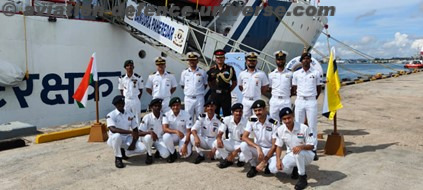By Varun Arora
New Delhi. With the launch of INS Vikrant two years ago, India’s first indigenously built aircraft carrier, Indian Navy is now emphasizing upon complete indigenization of technologies to modernize and expand its maritime capabilities. After their launch in water, ships and submarines suffer from the problem of corrosion which adds additional costs in maintenance if proper measures are not taken right from the designing stage.
Corrosion results due to the desire of metals to return to their native state i.e. oxides, conversion to oxides requires oxygen which is present in both air and water. Also, presence of salts (mostly chlorides) in sea water creates conducting medium which results in galvanic corrosion. Galvanic corrosion occurs when two dissimilar metals comes into contact with each other through an electrically conducting medium, in this one metal acts as anode and corrodes quickly while other metal acts as cathode and corrodes slowly or may not corrode at all. Corrosion costs India a loss of Rs 1.5 lakh crore every year (this also includes other sectors like vast railways lines, bridges, manufacturing units etc.).
The most striking example of damage of ships due to corrosion is the disintegration of USS Independence, the Littoral Combat Ship. The disintegration was due to galvanic corrosion, in USS Independence steel water jet propulsion system was in contact with aluminum hull and sea water acted as an electrolyte, as there was no electrical insulation between the two metals aggressive corrosion resulted.
Corrosion can be prevented by a number of methods like use of corrosion inhibitors, corrosion resistant metals, cathodic protection, changing the pH of the local environment, and use of protective coatings. Each method has its own advantages and disadvantages, with some being costly and other not being efficient enough. Cathodic protection involves placement of a metal having lower electrochemical potential in electrical contact with metal to be protected, in this way the lower potential metal will act as a sacrificial anode and will corrode. Protective coatings such as paints or ceramics not just prevent corrosion but also offer advantages like thermal insulation, prevention of mold growth, wear resistance etc. However, most paints and powders used in coatings are porous and allow oxygen to reach the underlying protective material.
Nanotechnology involves use of materials with size below 100 nm, in this size range the properties like as mechanical strength, melting point, electrical conductivity, optical properties, magnetic permeability, and chemical reactivity change due to their large surface area and quantum effects, for example gold at nanoscale is red or purple in color instead of yellow.
There are many nanotechnology based coatings which are being used to prevent corrosion in ships and submarines. In nanoceramic coating of alumina (Al2O3) and titania (TiO2), nanoparticles of alumina and titania are agglomerated by dispersing them in a fluid containing a binder and sprayed onto substrate under the conditions that favor partial melting. The resulting coating shows a remarkable increase in wear and bond strength as compared to the conventional ceramic coating of the same composition. These coatings are being used to eliminate galvanic corrosion in submarines.
A multiple coating consisting of Single Wall Carbon Nanotube (SWNT), zinc dust, and epoxy/polyamide primer is being sold under the tradename of Teslan® by Tesla Nanocoatings. In this, SWNT provides an electrically conductive path through the resin system for Zinc to act as a sacrificial anode for protection against corrosion and also strengthen the epoxy/polyamide matrix.
Nanotechnology based superhydrophobic coating can prevent growth of sea organisms on surfaces exposed to sea water, corrosion, and also reduces friction drag for ship’s hulls.



























































































































